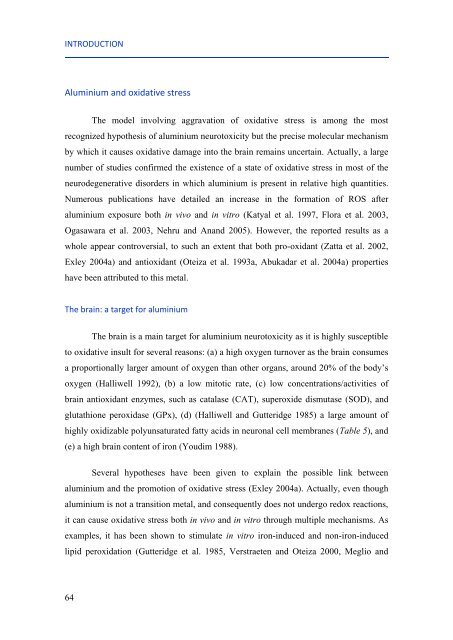Mechanisms of aluminium neurotoxicity in oxidative stress-induced ...
Mechanisms of aluminium neurotoxicity in oxidative stress-induced ...
Mechanisms of aluminium neurotoxicity in oxidative stress-induced ...
Create successful ePaper yourself
Turn your PDF publications into a flip-book with our unique Google optimized e-Paper software.
INTRODUCTION<br />
Alum<strong>in</strong>ium and <strong>oxidative</strong> <strong>stress</strong><br />
64<br />
The model <strong>in</strong>volv<strong>in</strong>g aggravation <strong>of</strong> <strong>oxidative</strong> <strong>stress</strong> is among the most<br />
recognized hypothesis <strong>of</strong> <strong>alum<strong>in</strong>ium</strong> <strong>neurotoxicity</strong> but the precise molecular mechanism<br />
by which it causes <strong>oxidative</strong> damage <strong>in</strong>to the bra<strong>in</strong> rema<strong>in</strong>s uncerta<strong>in</strong>. Actually, a large<br />
number <strong>of</strong> studies confirmed the existence <strong>of</strong> a state <strong>of</strong> <strong>oxidative</strong> <strong>stress</strong> <strong>in</strong> most <strong>of</strong> the<br />
neurodegenerative disorders <strong>in</strong> which <strong>alum<strong>in</strong>ium</strong> is present <strong>in</strong> relative high quantities.<br />
Numerous publications have detailed an <strong>in</strong>crease <strong>in</strong> the formation <strong>of</strong> ROS after<br />
<strong>alum<strong>in</strong>ium</strong> exposure both <strong>in</strong> vivo and <strong>in</strong> vitro (Katyal et al. 1997, Flora et al. 2003,<br />
Ogasawara et al. 2003, Nehru and Anand 2005). However, the reported results as a<br />
whole appear controversial, to such an extent that both pro-oxidant (Zatta et al. 2002,<br />
Exley 2004a) and antioxidant (Oteiza et al. 1993a, Abukadar et al. 2004a) properties<br />
have been attributed to this metal.<br />
The bra<strong>in</strong>: a target for <strong>alum<strong>in</strong>ium</strong><br />
The bra<strong>in</strong> is a ma<strong>in</strong> target for <strong>alum<strong>in</strong>ium</strong> <strong>neurotoxicity</strong> as it is highly susceptible<br />
to <strong>oxidative</strong> <strong>in</strong>sult for several reasons: (a) a high oxygen turnover as the bra<strong>in</strong> consumes<br />
a proportionally larger amount <strong>of</strong> oxygen than other organs, around 20% <strong>of</strong> the body‟s<br />
oxygen (Halliwell 1992), (b) a low mitotic rate, (c) low concentrations/activities <strong>of</strong><br />
bra<strong>in</strong> antioxidant enzymes, such as catalase (CAT), superoxide dismutase (SOD), and<br />
glutathione peroxidase (GPx), (d) (Halliwell and Gutteridge 1985) a large amount <strong>of</strong><br />
highly oxidizable polyunsaturated fatty acids <strong>in</strong> neuronal cell membranes (Table 5), and<br />
(e) a high bra<strong>in</strong> content <strong>of</strong> iron (Youdim 1988).<br />
Several hypotheses have been given to expla<strong>in</strong> the possible l<strong>in</strong>k between<br />
<strong>alum<strong>in</strong>ium</strong> and the promotion <strong>of</strong> <strong>oxidative</strong> <strong>stress</strong> (Exley 2004a). Actually, even though<br />
<strong>alum<strong>in</strong>ium</strong> is not a transition metal, and consequently does not undergo redox reactions,<br />
it can cause <strong>oxidative</strong> <strong>stress</strong> both <strong>in</strong> vivo and <strong>in</strong> vitro through multiple mechanisms. As<br />
examples, it has been shown to stimulate <strong>in</strong> vitro iron-<strong>in</strong>duced and non-iron-<strong>in</strong>duced<br />
lipid peroxidation (Gutteridge et al. 1985, Verstraeten and Oteiza 2000, Meglio and

















